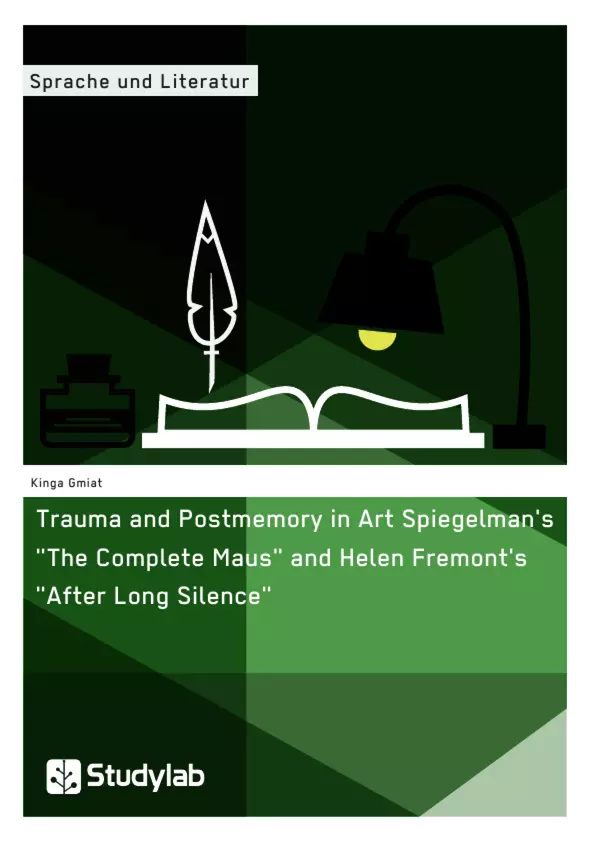The Holocaust represents an immense historical as well as a cultural trauma. The following thesis talks about the trauma symptoms and the behavior of Holocaust victims, including a broad selection of scholarly research on the Holocaust aftermath.
Afterwards, features of postgeneration art will be presented in detail, as second generation literature and art mirrors the depression and horrid state of the mind of survivors. By analyzing Art Spiegelmann’s “The Complete Maus” and Helen Fremont's "After Long Silence" this thesis aims at portraying the degree of traumatization as well as the extent to which the second generation is affected by the traumatic experiences of the parents´ lives.
Contents:
- Symptoms of psychological trauma and behavior,
- Recovery and the Necessity of a Story,
- Direct and Indirect Trauma,
- The Concept of Postmemory: Familial Transmission of Trauma,
- The Silence of the First Generation.
Inhaltsverzeichnis (Table of Contents)
- Introduction
- Psychological Trauma
- Symptoms and Behavior
- Prolonged Trauma and Captivity
- Recovery and the Necessity of a Story
- Trauma in Art Spiegelman's The Complete Maus
- Reading Comics
- Direct and Indirect Trauma
- The Parallelism between Graphic Narrative and Trauma
- The Concept of Postmemory
- Familial Transmission of Trauma
- The Postgeneration
- Second Generation Art
- Postmemory in Art Spiegelman's The Complete Maus
- Possession by History and Antagonistic Behavior
- Forming a Version of the Past
- Trauma and Postmemory in Helen Fremont's After Long Silence
- The Permanent Silence of the First Generation
- A Hindered Quest for an Unknown Past
- Breaking the Silence
Zielsetzung und Themenschwerpunkte (Objectives and Key Themes)
This work explores the lasting impact of trauma, particularly the Holocaust, on individuals and generations. It examines the complex relationship between psychological trauma, the transmission of trauma across generations, and the role of art in processing and understanding traumatic experiences. The study focuses on two specific works: Art Spiegelman's "The Complete Maus" and Helen Fremont's "After Long Silence."
- The long-term effects of trauma on victims of genocides and catastrophes
- The concept of postmemory and its role in transmitting trauma across generations
- The use of graphic narrative as a means of processing and understanding trauma
- The challenges of recovering from trauma and the necessity of storytelling
- The role of art in breaking the silence surrounding traumatic experiences
Zusammenfassung der Kapitel (Chapter Summaries)
The introduction sets the stage by discussing the lasting impact of the Holocaust on individuals and society. It highlights the importance of understanding both the immediate and long-term consequences of trauma, particularly for the "second generation" who did not directly experience the Holocaust but are still affected by its legacy.
Chapter 2 delves into the nature of psychological trauma, exploring its symptoms, behavioral manifestations, and the challenges of recovery. It examines the concept of prolonged trauma, particularly in the context of captivity, and emphasizes the role of storytelling in healing.
Chapter 3 focuses on the portrayal of trauma in Art Spiegelman's "The Complete Maus." It analyzes the graphic novel's depiction of direct and indirect trauma, exploring the parallels between graphic narrative and the experience of trauma.
Chapter 4 introduces the concept of postmemory, which describes the transmission of trauma across generations. It examines how the experiences of the first generation, who directly experienced the Holocaust, continue to shape the lives and identities of subsequent generations.
Chapter 5 investigates the presence of postmemory in "The Complete Maus," analyzing how the narrative reflects the impact of the Holocaust on both the first and second generations. It examines the themes of possession by history and the struggle to form a coherent version of the past.
Chapter 6 explores trauma and postmemory in Helen Fremont's "After Long Silence," focusing on the challenges faced by the second generation in confronting the silence surrounding their parents' traumatic experiences. It examines the quest for an unknown past and the process of breaking the silence.
Schlüsselwörter (Keywords)
This work explores the complex interplay of trauma, memory, and art, focusing on the Holocaust as a historical and cultural trauma. Key terms and concepts include: trauma, postmemory, second generation, graphic narrative, Holocaust, art, silence, storytelling, recovery, and transmission.
- Citar trabajo
- BA Kinga Gmiat (Autor), 2015, Trauma and Postmemory in Art Spiegelman's "The Complete Maus" and Helen Fremont's "After Long Silence", Múnich, GRIN Verlag, https://www.grin.com/document/317822



